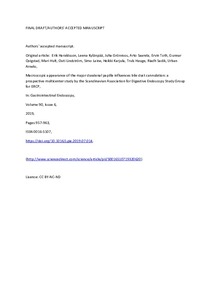Macroscopic appearance of the major duodenal papilla influences bile duct cannulation: a prospective multicenter study by the Scandinavian Association for Digestive Endoscopy Study Group for ERCP
Haraldsson Erik; Kylänpää Leena; Grönroos Juha; Saarela Arto; Toth Ervin; Qvigstad Gunnar; Hult Mari; Lindström Outi; Laine Simo; Karjula Heikki; Hauge Truls; Sadik Riadh; Arnelo Urban
https://urn.fi/URN:NBN:fi-fe2021042825738
Tiivistelmä
Background and Aims
Certain appearances of the major duodenal papilla have been claimed to make cannulation more difficult during ERCP. This study uses a validated classification of the endoscopic appearance of the major duodenal papilla to determine if certain types of papilla predispose to difficult cannulation.
Methods
Patients with a naïve papilla scheduled for ERCP were included. The papilla was classified into 1 of 4 papilla types before cannulation started. Time to successful bile duct cannulation, attempts, and number of pancreatic duct passages were recorded. Difficult cannulation was defined as after 5 minutes, 5 attempts, or 2 pancreatic guidewire passages.
Results
A total of 1401 patients were included from 9 different centers in the Nordic countries. The overall frequency of difficult cannulation was 42% (95% confidence interval [CI], 39%-44%). Type 2 small papilla (52%; 95% CI, 45%-59%) and type 3 protruding or pendulous papilla (48%; 95% CI, 42%-53%) were more frequently difficult to cannulate compared with type 1 regular papilla (36%; 95% CI, 33%-40%; both P < .001). If an inexperienced endoscopist started cannulation, the frequency of failed cannulation increased from 1.9% to 6.3% (P < .0001), even though they were replaced by a senior endoscopist after 5 minutes.
Conclusions
The endoscopic appearance of the major duodenal papilla influences bile duct cannulation. Small type 2 and protruding or pendulous type 3 papillae are more frequently difficult to cannulate. In addition, cannulation might even fail more frequently if a beginner starts cannulation. These findings should be taken into consideration when performing studies regarding bile duct cannulation and in training future generations of endoscopists.
Kokoelmat
- Rinnakkaistallenteet [27094]
